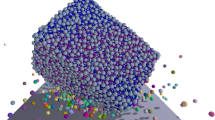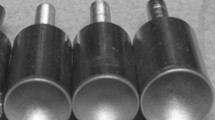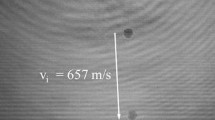Abstract
The case of a single erosion impact is considered. The paper improves and extends the results from Argatov and Mishuris (Philos Mag 93:2485, 2013), where a lower bound for the threshold fracture energy of a rigid axisymmetric indenter was obtained based on the notion of incubation time prior to fracture. In the presented study we define an exact value for the initial energy required for fracture initiation and compare it with previous results. The incubation time based fracture criterion is utilized in order to locate the time of the initial fracture, along with the associated radial position. A brief examination of the effects of different particle parameters on the initial fracture is conducted.














Similar content being viewed by others
References
Melosh HJ (1989) Impact cratering. Oxford University Press, New York
Śledź M, Bąk Ł, Stachowicz F, Zielecki W (2013) Analysis of the effect of shot peening on machanical properties of steel sheets used as screener sieve materials. J Phys Conf Ser 451:012029
Lankford J Jr (2004) The role of dynamic material properties in the performance of ceramic armor. Int J Appl Ceram Technol 1:205–210
Evans AG (1978) On impact damage in the elastic response regime. J Appl Phys 49:3304–3310
Petrov YV, Morozov NF, Smirnov VI (2003) Structural macromechanics approach in dynamics of fracture. Fatigue Fract Eng Mater Struct 26:363–372
Subhash G, Maiti S, Geubelle PH, Ghosh D (2008) Recent advances in dynamic indentation fracture, impact damage and fragmentation of ceramics. J Am Ceram Soc 91:2777–2791
Argatov II, Nazarov SA (2000) Comparison of the Griffith and Irwin criteria for a crack asymmetrically propagating in the place. Mater Sci 36:561–569
Neal-Sturgess CE (2008) A direct derivation of the Griffith–Irwin relationship using a crack tip unloading stress wave model. arXiv:0810.2218
Bagherifard S, Fernandez-Pariente I, Ghelichi R, Guagiano M (2014) Effect of severe shot peening on microstructure and fatigue strength of cast iron. Int J Fatigue 65:64–70
Satapathy S (2001) Dynamic spherical cavity expansion in brittle ceramics. Int J Solids Struct 38:5833–5845
Iyer KA (2007) Relationships between multiaxial stress states and internal fracture patterns in sphere-impacted silicon carbide. Int J Fract 146:1–18
Jianming W, Feihong L, Feng Y, Gang Z (2011) Shot peening simulation based on SPH method. Int J Adv Manuf Technol 56:571–578
Wang Y-F, Yang Z-G (2008) Finite element model of erosive wear on ductile and brittle materials. Wear 265:871–878
Petrov YV (1996) Quantum analogy in the mechanics of fracture of solids. Phys Solid State 38:1846–1850
Petrov Y (2012) Incubation time based fracture mechanics. In: 19th European conference on fracture; fracture mechanics for durability
Bratov V, Petrov Y (2007) Application of incubation time approach to simulate dynamic crack propogation. Int J Fract 146:53–60
Zh-Ch O, Yan C, Duan Z-P, Pi A-G, Huang F-L (2012) Dynamic behaviors of load-carrying capacity of brittle materials. Int J Impact Eng 42:59–65
Argatov II, Dmitriev NN, Petrov YuV, Smirnov VI (2009) Threshold erosion fracture in the case of oblique incidence. J Frict Wear 30:245–253
Morozov N, Petrov Yu (2000) Dynamics of fracture. Springer, Berlin
Petrov YuV (2007) On the incubation stage of fracture and structural transformations in continuous media under pulse energy injection. Mech Solids 42:692–699
Petrov Y (2014) Fracture, electric breakdown and phase transformations under impact loading. Proc Mater Sci 3:467–472
Volkov GA, Gorbushin NA, Petrov YuV (2012) On the dependence of the threshold fracture energy of small erodent particles on their geometry in erosion fracture. Mech Solids 47:491
Gorbushin NA, Volkov GA, Petrov YuV (2013) On the effect of the geometrical shape of a particle on threshold energy in erosion damage. Tech Phys 58:388–392
Argatov I, Mishuris G, Petrov Yu (2013) Threshold fracture energy in solid particle erosion. Philos Mag 93:2485
Shtaerman IY (1939) On the Hertz theory of local deformations resulting from the pressure of elastic solids. Doklady Akad Nauk SSSR 25:360 (in Russian)
Kilchevsky NA (1969) The theory of solid bodies collision. Naukova Dumka, Kiev (in Russian)
Galin LA (1946) Spatial contact problems of the theory of elasticity for punches of circular shape in planar projection. J Appl Math Mech (PMM) 10:425 (in Russian)
Galin LA (2008) Contact problems—the legacy of L.A. Galin. Springer, Netherlands, p 266
Johnson KL (1985) Contact mechanics. Cambridge University Press, Cambridge, pp 76–79
Petrov Y, Bratov V, Volkov G, Dolmatov E (2011) Incubation time based fracture mechanics and optimization of energy input in the fracture process of rocks. In: Zhou Y, Zhao J (eds) Advances in rock dynamics and applications. CRC Press, Boca Raton, pp 163–183
Borodich FM (1989) Hertz contact problems for an anisotropic physically nonlinear elastic medium. Strength Mater 21:1668–1676
Fischer-Cripps AC (2007) Introduction to contact mechanics. Springer, New York, pp 87–108
Petrov YV (2004) Incubation time criterion and the pulsed strength of continua: fracture, cavitation, and electrical breakdown. Doklady Phys 49:246
Petrov YuV, Smirnov VI (2010) Interrelation between the threshold characteristics of erosion and spall fracture. Tech Phys 55:23
Acknowledgments
Yu.P. acknowledges Saint-Petersburg State University for research grants 6.38.243.2014 and 6.39.319.2014. G.M. and D.P. gratefully acknowledge the support of the European Union Seventh Framework Marie Curie Programme PARM-2 (project reference: PIAP-GA-2012-284544-PARM2), and M.W. acknowledges the European Union FP7 project INTERCER2 (reference: PIAP-GA-2011-286110-INTERCER2). All authors would like to thank Prof. I. Argatov and Prof. S. Mikhailov for their useful discussions and insightful comments.
Author information
Authors and Affiliations
Corresponding author
Rights and permissions
About this article
Cite this article
Peck, D., Wrobel, M., Mishuris, G. et al. Threshold fracture energy in solid particle erosion: improved estimate for a rigid indenter impacting an elastic medium. Meccanica 50, 2995–3011 (2015). https://doi.org/10.1007/s11012-015-0173-5
Received:
Accepted:
Published:
Issue Date:
DOI: https://doi.org/10.1007/s11012-015-0173-5




